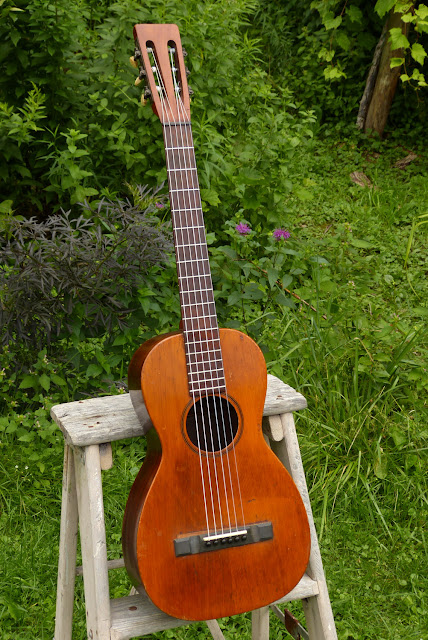1890s Bay State Style Z Parlor Guitar
This is a customer's guitar that was rescued, as I recall, from a thrift store. Per its serial number at the headstock, it dates from somewhere between 1890 and 1895. Aside from the bridge, saddle, and bridge pins it's also all-original. Haynes out of Boston made the Bay State line, among others, and built banjos, mandolins, and quite a lot of guitars.
Style Z was, apparently, a step up from the entry-level Bay State and this one totes Brazilian rosewood back and sides. The neck is mahogany and the fretboard is rosewood (with a tight, 10" radius). The original bridge would have been rosewood, too, but it was long gone when this came to me and replaced with a 1960s Harmony-sourced bridge that was glued at entirely the wrong angle. It also came with a number of side cracks that were sloppily-repaired and several that were still open. Fortunately, the neck itself was straight from the get-go.
My work included a neck reset, fret seating and level/dress job, removal of the replacement bridge and installation of a parts-bin 1890s Lyon & Healy bridge, some crack and seam repairs, a new saddle and new ebony pins, and a good setup with Aquila Nylgut strings. It's now stable in service and sounds intimate, full for its size, and plays fantastic. I have action set at my normal "classical" height of 3/32" at the 12th fret. The saddle is quite tall so it can be adjusted as desired.
Style Z is pretty plain and has no binding and a darkened, orange-brown top color.
This guitar is only 11" on the lower bout and that was fairly standard for the average guitar at this time, but these days it looks like a somewhat-outsized baritone ukulele.
The nut width is 1 7/8" and it has a 24 5/8" scale length -- 5/8" longer than most guitars of the era. The neck profile is a sharp, medium-depth V-shape. Despite the thin lower bout, it has a 3 5/8" depth which allows more low-end sound than you might expect.
The original ebony nut is still good to go.
I added side dots at 5, 7, and 9 to make this a little easier for modern players to use.
The "bare wood" in front of the bridge shows how far-off the older replacement bridge was when it was glued. This 1890s Lyon & Healy bridge not might be "right" for the instrument (these had rosewood, pyramid bridges when made), but at least it's period and looks "correct" age-wise.
I love that rosewood!
These neck joints have tenons and -- from my point of view -- do not really have sufficient gluing surface to keep them steady over time. When I reset them I reshape the heel, glue as normal, and then also install a tiny keeper bolt/screw hidden at the inside of the neckblock to make sure that if this gets into a situation where the glue softens (hot car, heaven forbid) that the neck doesn't come flying off.
I love those bone-buttoned tuners!
Here's the ugliest of those old crack repairs. There are a number of them but they're all holding-up just fine.




















Comments